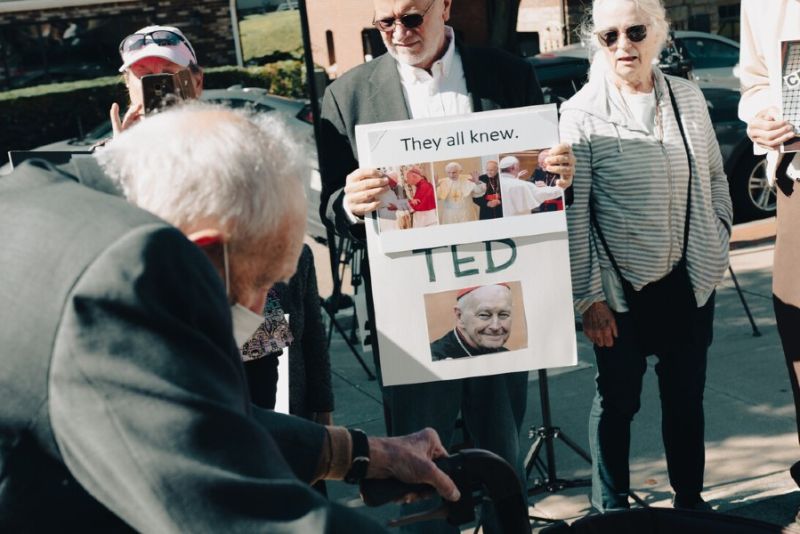
CNA Staff, Nov 24, 2024 / 15:25 pm (CNA).
A bishop in Illinois has halted in his diocese a traveling tour of a relic of St. Jude following an “incident” that allegedly took place between a visiting priest and several students.
A statement from Father Michael Lane and Father Gregory Alberts at Queen of the Apostles Catholic Church in Joliet, Illinois, said that on Thursday of this week the parish hosted the arm of St. Jude as part of the relic’s ongoing tour throughout the United States.
A priest with the Canadian order Companions of the Cross was overseeing the relic’s visit through the “Treasures of the Church” ministry, the statement said.
During the visit, “an incident with the priest and some students was reported to have happened in our church,” it continued.
“We immediately contacted the police,” the priests said. “A police investigation is still ongoing. The priest was confronted with the information. We informed the priest that he must depart from our parish and out of our diocese.”
The priests subsequently canceled the remainder of the relic’s visit, they said. They further informed Joliet Bishop Ronald Hicks, who “canceled the tour of the relic scheduled at two more of our parishes this week.”
The bishop “also informed the superior of the Companions of the Cross Order of priests” of the incident.
“All involved in this incident are safe,” the priests wrote.
The statement did not identify the priest by name, though the Pillar on Saturday evening reported that the priest was Father Carlos Martins, the director of Treasures of the Church. The ministry said last August that Martins would be leading the St. Jude relic tour throughout the United States.
CNA could not immediately confirm whether Martins was the priest referenced in the statement. Reached by CNA on Sunday afternoon, Martins declined to comment.
Treasures of the Church is based out of Michigan. It identifies itself as a “ministry of evangelization of the Catholic Church” that exists “to give people an experience of the living God through an encounter with the relics of his saints in the form of an exposition.”
Martins is also known for his ministry as an exorcist. The podcast “The Exorcist Files,” hosted by Martins and Ryan Bethea, topped the charts last year with what are claimed to be dramatic reenactments of the priest’s case files.
This is a developing story.
If you value the news and views Catholic World Report provides, please consider donating to support our efforts. Your contribution will help us continue to make CWR available to all readers worldwide for free, without a subscription. Thank you for your generosity!
Click here for more information on donating to CWR. Click here to sign up for our newsletter.






Sounds weird to say the least.
Probably diabolical in nature.
I wonder what awful thing this priest did to upset the students? The lack of detail makes it seem like it was pretty horrible. I hope the students really are safe.
More likely the students were doing something to the relic. I know Fr. Carlos. This is a witch hunt.
This CNA article is a perfect example of sensationalist journalism and is unworthy of CWR. The piece reports scandal, an “incident” but provides absolutely no detail. Add to that, an unsubstantiated name was dropped followed by the temerity of stating that “This is a developing story.”
The author would have done better to let it develop some more. This piece reminds of a sewing circle of breathless, gossiping busybodies.
Joseph Meynier: my sentiments exactly. I’ve thought for a long time that CNS is not a reliable source of news and ought to be considered with a very critical eye.
Sorry, I meant to say CNA.
Thank you. This is the first time I can remember being disappointed in something CWR published, but someone was a definitely a bit too eager.
I’m a bit puzzled by the responses here. It’s a straight-up news report. There is no sensationalism, no editorializing, no claims made. Just facts. This did happen and it is, as the CNA note states, a developing story.
What was printed was all the information that the diocese made available. It would have been so easy (and fair-minded) for them to have specified that the incident was not of a sexual nature. But they didn’t and now the priest’s reputation is harmed and Joliet Catholics are deprived of the chance to honor the relic.
Agreed. Lack of essential detail. Therefore,not newsworthy
I hope that when the details of the case are known, you will update this article, so we can know the exact nature of the allegations against the unnamed priest, and the identity of the individual.
The accusations are false against fr martins…thevtruthvwill come out…he is being attacked by Satan for his work exposing satan….beware of jumping to false conclusions….
I attended the display when it came through our parish. Nothing weird happened here. I really enjoyed it.
I would suggest, if it turns out that this priest did nothing illegal or immoral according to Church teaching and if his reputation was damaged by the action taken by the diocese of Joliet and its bishop, that he ought to then sue the latter for damages.
Relic priest responds to ‘incident’ allegation
THE PILLAR
November 25, 2024 . 2:51 PM 5 min read
Apparently, this priest is alleged to have handled the long hair of a girl attending the relic presentation in order to illustrate a point. Probably unwise but hardly an illegal “assault” as alleged nor a violation of morality. As a comparison, I’m sure we can all recall photos of Pope Francis in all sorts of fatherly embraces of young children yet no one lodges a single complaint about it.
Those were my thoughts too, Deacon Edward.
A recent update by the Pillar has more details as indicated earlier. As the saying goes someone seems to have made a mountain out of a molehill. In this case, a priest making note of his bald head and a girls hair to some students to engage them in a discussion. If the Pillar latest account holds true as of this writing, which I hope it is, then the person making a report to the police should be admonished and should publically issue an apology to the priest. Also think if the Pillar up date is true then I think the Father making a report to the police has his own issues leading to this situation. Think CWR should also do an update when final facts are known.
Grabbintg anyone’s hair for any reason, without their consent is certainly immoral.
And I would lock up Francis and throw away the key for hundreds of things he has done.
No idea how you can define this as immoral?
As usual, this is turning out to be a witch hunt brought on by a hyper-conscious parent and the regular group of ninnies that try to make every good priest a villain. Fr. Martins did nothing wrong. See the latest:
https://www.ncregister.com/cna/illinois-diocese-halts-st-jude-relic-tour-amid-incident-involving-priest-students
Waiting for the pastor of the church and the bishop of Joliet to restore Father Martins’ reputation.
Unfortunately, Daniel Payne left out significant details in his article about the allegations against Fr. Martins. In front of over 200 people, as
Fr. Martins joked about his baldness he touched a teen’s hair. The girl’s father complained of assault. This ridiculous act against Fr. Martins may be an example of how Satan attacks the highly faithful. Fr. Martins is a well-known exorcist. Remember how Fr. Pio was also attacked with false charges. In this case, numerous witnesses shared that nothing inappropriate happened.
After reading the additional information in the Pillar, I think this is all diabolical. Fr. Martins is an accomplished exorcist. The evil one hates him.
How devastating this must be for him. Yet, he’ll come through it.
And I agree the Bishop over reacted as did the parent.